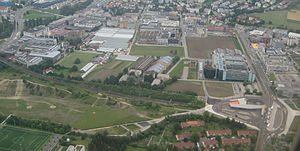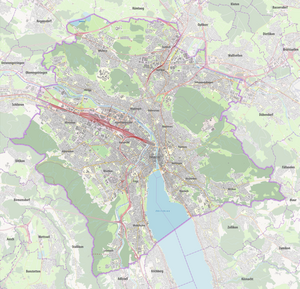Zurichberg tunnel
| Zurichberg tunnel | ||
|---|---|---|
|
Aerial view of the east portal with the Stettbach tram stop (June 2011)
|
||
| use | Railway tunnel | |
| place | Adlisberg , Zurich | |
| length | 4968 m | |
| Number of tubes | 1 (section of 500m2) | |
| construction | ||
| completion | 1990 | |
| location | ||
|
|
||
| Coordinates | ||
| Stadelhofen | 683956 / 246720 | |
| Stettbach | 687416 / 250346 | |
The Zürichberg Tunnel is a railway tunnel in the city of Zürich . It connects the Stadelhofen station with the Stettbach station and was opened in 1990. Its length from portal to portal is 4968 meters. The main part of Stettbach station is located in the Zürichberg tunnel, with Stadelhofen station immediately adjacent.
Contrary to what the name suggests, the tunnel does not run through the Zürichberg , but under the lesser-known Adlisberg to the south .
history
The possibility of a tunnel under the Zürichberg was discussed by the Swiss National Railways as early as the 1870s . A branch line from Kloten through the Zürichberg with a train station near the Alte Tonhalle (today Sechseläutenplatz ) was supposed to connect the city of Zürich to the national railway. At the time, however, the project turned out to be impossible.
After a submission for the U- and S-Bahn Zurich was rejected by the voters in 1973, it quickly became clear that this was mainly due to the fact that the submission package was too large. The proposed S-Bahn network, however, seemed to have a majority. So they went over the books again and tried to design a resized project that only included the S-Bahn. It quickly became clear that an expansion of the main station would be inevitable for the introduction of the Zurich S-Bahn . Since this is designed as a terminal station , the will for a low through station was great. The directly adjoining Hirschengraben tunnel was supposed to make it possible to abolish the single-lane route over the Letten station , but in order to relieve the Oerlikon station , a second line from the Limmattal into the Glatttal in the direction of Winterthur was necessary.
A route was chosen from four possible variants, which should lead after Stadelhofen station through the Zürichberg tunnel into the Glatttal. The continuation, the main structure of which is the Neugut Viaduct, was to cross the Glatthalbahn and join the existing Oerlikon – Wallisellen – Effretikon – Winterthur railway at Dietlikon station. The Glatthalbahn was to be connected to the new route with a structure free of intersections. This approximately 12-kilometer-long new line became the main component of the resized project that was submitted to the electorate again in November 1981. This time, the people of Zurich approved the project and the canton's financial contribution of CHF 523 million.
The prerequisites for the construction of the Zürichberg Tunnel were thus met.
planning
With the new line, particular consideration had to be given to the problems that a major construction site in the city brings with it. In many places had to be catered to existing underground structures, so the construction of the " Station Museum Street " under the main station, the Hirsch grave tunnel just east of the main station, the Limmat passes under, and in Zurich Tunnel, for which the heart of the city in the neighborhood Hottingen a A shaft had to be created in which the tunnel boring machine was dismantled. For the so-called Antonius shaft , future use also had to be taken into account.
Construction work
The construction of the tunnel can be divided into four sections:
- the Kreuzbühlstrasse branching plant, where the tunnel joins the Riesbach tunnel of the right bank of the Zürichseebahn from Rapperswil
- the Antoniusschacht, where two single-track tunnels lead east to the crossing structure and directly to the Stadelhofen train station and the double-track Zurichberg tunnel begins
- the actual, double-lane Zürichberg tunnel
- Stettbach station, which is partially covered.
If possible, a slab track was installed.
Section of the Kreuzbühlstrasse branching plant
This construction phase was a great challenge because the Riesbach tunnel could not be shut down for a long time. A rail replacement service could only be maintained during the summer holidays, at other times the flow of commuters was too great. In addition, a tram line operated by the Zurich Transport Authority runs through Kreuzbühlstrasse , which is also used by the Forchbahn and which could not be interrupted for a long time. In addition, there are buildings on both sides of the street that are subject to monument protection, so that the available space for the construction site was limited to the axis of the street. So after the utility lines had been laid, an auxiliary bridge first had to be built on which traffic could run during the construction period. This is based on the previously constructed lake-side tunnel wall. On the mountain side it rested on supports. Then the mountain side wall could be created. The old vault of the Riesbach tunnel also had to be secured. This was done with a steel girder frame, the spaces between which were filled with concrete. Thanks to this reinforcement, part of the ceiling could be created without removing the vault under the auxiliary bridge. During the 1986 summer vacation, the relevant part of the Riesbach tunnel was demolished and the rest of the tunnel ceiling was built within a four-week interruption in operation of the Seeline. The part of the floor slab on which the sea line came to rest was also completed. Then the new tunnel could be covered again, the roads restored and the auxiliary bridge dismantled.
Construction section Antoniusschacht
Because the connection to the tunnel section, which was made with a tunnel boring machine, could not be made from Stadelhofen station, an interim solution had to be found. The tunnel also descends quickly from Stadelhofen station in order to reach the solid rock layers earlier. The place in front of the St. Antonius Church on Klosbachstrasse was found as the installation site for the shaft. Since the church foundation had planned a new building on the area, an interim use of the area was obvious. The fact that the Federal Supreme Court agreed to this solution was a fortunate coincidence for the tunnel construction. At this point the full molasse cover of the tunnel axis ends, and the two single-track tunnels towards Stadelhofen and Kreuzbühlstrasse branching plant begin at the foot of the shaft.
For the first time in Switzerland, a method with a horizontal jet pole screen was used to drill the two single-track tunnels, which was able to prevail against the freezing process. For the excavation, a roadheading machine with a cutter head was used, with which the dismantling cavern for the tunnel boring machine was also created.
The underpass of various buildings, including the First Church , which was underrun less than eight meters, was particularly tricky . Due to the low overlap and the resulting transmission of structure-borne noise, a light mass-spring system was installed in both single-track tunnels .
The Antonius shaft was not filled. An eight-story civil defense facility with around 1,100 places was built in it. Storage rooms for the cultural assets of the State Archives of the Canton of Zurich were also set up in the former shaft . In the shaft there are also archives of important former Zurich companies such as Escher Wyss AG and the Hürlimann brewery .
Construction section of the Zürichberg tunnel
Thanks to the optimized lines and the Antonius shaft, it was possible to achieve that the tunnel to be built by mining from the Stettbach side came to rest in solid rock throughout. This consists largely of the upper freshwater molasse, which was already well known from other structures around Zurich. Since this tends to swell, a stable tunnel lining was necessary. For this reason, a generous circular profile was chosen for mechanical tunneling. The excavation was carried out in shield driving with a tunnel boring machine with a full cutting head. The drill head was 11.52 meters in diameter and the excavated cross-section was 104 m².
Stettbach station construction phase
Of the roughly 900 meter long incision in which the entire Stettbach train station and the lane change points came to lie, 425 meters were subsequently covered. This covers around two thirds of the approximately 300 meter long platform. The station is on the city limits between Zurich and Dübendorf . The incision was dug into the gently sloping ground, the bottom of which is eleven meters lower than the original surface at the south-western end. The long cut resulted from the necessity that the tunnel boring machine could be started. Since the distance between the tracks has increased to twelve meters due to the central peron in the station, the open construction method was obvious.
Operational
In line with its intended purpose, the tunnel is mainly used by S-Bahn trains. Occasional mail and long-distance trains are not uncommon, however. The Zürichberg tunnel is one of the busiest rail tunnels in Switzerland. Maintenance and management are the responsibility of the SBB .
In the tunnel there is an access to the Antonius shaft. This would make it possible at night during the S-Bahn's break in operation to serve the warehouse of the State Archives with freight trains, for which the trains could stop at the foot of the Antoniusschachts.
See also
swell
literature
- Robert Fechtig, Max Glättli: Project planning and construction of the Zurich S-Bahn. Stäubli Verlag, ISBN 3-7266-0021-3
Individual evidence
- ↑ S. Zurlinden: Hundred Years: Pictures from the History of the City of Zurich in the Period from 1814-1914 . Рипол Классик, 1914, ISBN 978-5-87370-648-8 ( google.com [accessed October 9, 2017]).
- ↑ Tages-Anzeiger dated December 20, 2007, regional section Zurich City, page 55



